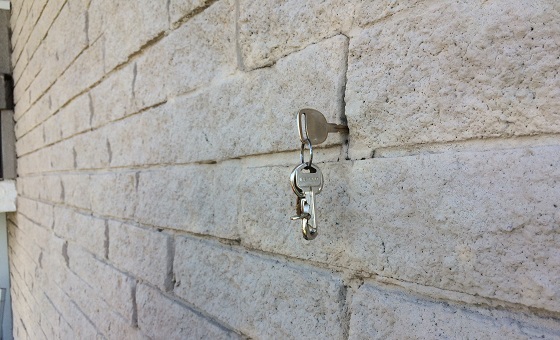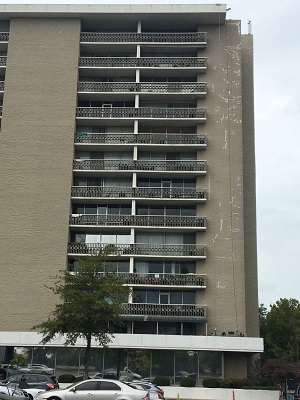The Quapaw Tower Condominiums building was constructed in 1967 in Little Rock, Ark. The 13-story high-rise sits south of the Arkansas River and just north of the city’s MacArthur Park, close to the junction of Interstates 30 and 630.
In 2016, the owner of the Quapaw Tower building noticed that its concrete masonry unit (CMU) block façade was experiencing leaks, cracks, and other damage. Western Specialty Contractors, a contractor specializing in restoration and preservation projects, has had an office in Little Rock since the 1950s and had previously worked on the building. They were called in to examine the problems and resolve the issues.
Inspect Then Repair
Western began by performing a thorough inspection of the high-rise’s façade. Travis DeJohn, the Arkansas branch manager for Western Specialty Contractors who was on site periodically as the job progressed, described the findings. “It’s a block building, and we found cracks in the mortar joints and the block itself,” he said.
Western’s Arkansas branch has 25 employees, and a crew of two to four people from that branch worked on this restoration job beginning in January 2017. The project involved 3,600 work hours over the course of a year. The crew began by performing sample repairs on the building’s north elevation, which exhibited the most significant leak issues and had no balconies to impede rigging and access.
With buy-in from the building’s owners on the sample repairs, the crew continued the masonry repair work on the remaining block façade, over which Western had to set up and take down 16 different swing stage drops.
“We had to access many balconies on the building to make repairs, put up protection, and access our swing stage,” said DeJohn. “The only way to access these balconies was through the owners’ residences. The coordination was handled through the on-site property management, foreman, superintendent, and project manager.”
Swing stages are a suspended scaffold system. “You secure weights and tiebacks and safety restrictions on the roof,” said DeJohn. “Then you drop down your lines and cables and hook up to a suspended scaffold or swing stage basket. For this job, there were balconies for each unit, so we had to shrink our stage to fit in between those.”

Fall protection equipment was crucial on this project as all work was performed from the swing stages. “We’re, as a company, 100-percent tied off at all times over 6 feet [1.8 m],” DeJohn stated.
In addition to working around occupied balconies, challenges on the project included working 13 stories over an open swimming pool and a full parking lot. Work noise was restricted so that the building’s residents would be disturbed as little as possible.
Making Some Noise
In all, the Western Specialty crew performed more than 11,000 linear feet (3,352.8 m) of crack repairs and tuckpointing.
“There’s a couple different repairs included in that 11,000,” explained DeJohn. “Some of it is tuckpointing, which is the mortar in between the blocks. That has to be removed with a saw or a chisel, depending on what you’re working on. So that mortar, over time, has cracked or deteriorated and needs to be replaced. You cut that out, depending on the specifications of the project, and then you point mortar back in. That can either be premixed mortar or, if it’s a historic job, you have specific strengths and designs that you have to match. This was not a historic building, so it didn’t require a specific mix.”
During the saw cutting process, dustless vacuum systems were used to collect the old mortar. “We use those on every project just for our internal safety rules and some external ones as well,” DeJohn said. The spent mortar is “bagged in the vacuum and disposed of properly,” he continued.
The team also had to coordinate the work with the condo’s property management. “It was obviously people’s residences,” said DeJohn. “The property management told us what time approximately we could start and what time we had to stop making that loud noise. When you’re removing that mortar, that can be pretty noisy.”
At times, work was stopped due to weather shutdowns. Cold temperatures under 40 °F (4.4 °C) affected not only the repair materials that the workers were using, but also the coatings later on in the project. DeJohn said, “You don’t want the mortar to freeze, and you don’t want the coating to freeze.” Therefore, it was important to stop work during those times of colder weather.
Resisting the Elements
When all of the mortar and crack repairs were complete on a section of the swing staging, Western Specialty did a thorough cleaning of the façade in that area. “We did have to clean the building with high-pressure water,” recalled DeJohn. “We tried to complete each section at a time just so we wouldn’t have to re-access that location.”
Finally, it was time to apply a protective elastomeric coating to the façade — a task that was also done in stages according to where the crew was positioned. This part consisted of rolling and brushing BASF’s MasterProtect HB 400 Smooth onto more than 60,000 square feet (5,574.2 m2) of masonry. “It was rolled because of a parking lot directly below and the apartments,” said DeJohn. “The spray-applied [coatings] can sometimes get in the air and cause some trouble.”
 According to BASF’s website, MasterProtect HB 400 is a water-borne, high-build, 100 percent acrylic, waterproof coating for above-grade concrete, masonry, stucco, and other applications. It is resistant to the elements and helps prevent water penetration into the substrate, which is exactly the kind of big-time protection the Quapaw Tower façade needed. The coating also provides ultraviolet (UV) resistance for long-term durability and colorfastness.
According to BASF’s website, MasterProtect HB 400 is a water-borne, high-build, 100 percent acrylic, waterproof coating for above-grade concrete, masonry, stucco, and other applications. It is resistant to the elements and helps prevent water penetration into the substrate, which is exactly the kind of big-time protection the Quapaw Tower façade needed. The coating also provides ultraviolet (UV) resistance for long-term durability and colorfastness.
Western Specialty used a custom color of HB 400 to match the existing color of the Quapaw Tower. DeJohn said that a BASF product had previously been used on the condo building, leading the property owners to choose BASF again.
The two-coat system of MasterProtect HB 400 Smooth was applied according to manufacturer recommendations to achieve a total dry film thickness (DFT) of 12–16 mils (304.8–406.4 microns). The crew had to allow for drying time between the two coats, but this wasn’t a problem. “Depending on the size of the drop,” said DeJohn, “I think we’d get to the bottom by the end of the day and then start the next coat the next day.” The product guide from BASF recommends a minimum recoat time of six hours, so they were well within the recommendations. They worked carefully and yet “as fast as possible with the restrictions that we were dealing with,” added DeJohn.
A Restored Façade
Western Specialty is known for its vast experience in restoration projects, and the expertise of the company was demonstrated yet again on the Quapaw Tower Condominiums building in Little Rock. Between the cold temperatures, the noise restrictions, and having to set up the swing stage 16 times, the team certainly faced some challenges, but they successfully restored the condo façade and gave it protection from the elements for many years to come.